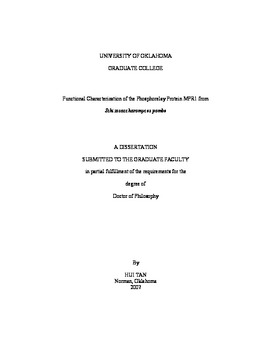| dc.contributor.advisor | West, Ann H., | en_US |
| dc.contributor.author | Tan, Hui. | en_US |
| dc.date.accessioned | 2013-08-16T12:20:38Z | |
| dc.date.available | 2013-08-16T12:20:38Z | |
| dc.date.issued | 2007 | en_US |
| dc.identifier.uri | https://hdl.handle.net/11244/1186 | |
| dc.description.abstract | The yeast two-hybrid assay indicates that MPR1 interacts with the response regulator domains of MAK3 (one of the three histidine kinases) and MCS4, but not with MAK1, MAK2 and PRR1. PRR1-RR weakly interacts with MAK1-HK, MAK2-HK and MAK3-HK. In vitro phosphorylation assay results showed that MPR1 could receive phosphoryl groups from phospho-MAK2-RR and transfer them to MCS4-R4, but not to PRR1-RR. These results suggest that one branch of the pathway is formed by MAK2/MAK3→ MPR1→ MCS4, and the other one is MAK1→ PRR1 in the His-Asp phosphorelay pathway in S. pombe . | en_US |
| dc.description.abstract | HPt proteins may have phosphotransfer specificity toward different response regulators. The phosphotransfer between YPD1 and SSK1-R2 was more rapid and favored than phosphotransfer between YPD1 and SKN7-R3 in vitro, while in a heterologous assay MPR1 favors phosphotransfer to SKN7-R3 over SSK1-R2, which is opposite to YPD1. To investigate any structural basis behind this phenomenon, the phosphotransfer specificity of mutated YPD1 and MPR1 was tested in vitro. None of the mutants could invert phosphotransfer specificity of YPD1. It is possible that the combined differences between the two proteins are responsible for the difference in phosphotransfer specificity. | en_US |
| dc.description.abstract | The yeasts Schizosaccharomyces pombe and Saccharomyces cerevisiae utilize not only serine/threonine/tyrosine phosphorylation that is dominant in the eukaryotic kingdom, but also employ histidine/aspartate phosphorylation that is mainly used in prokaryotic cell signal transduction systems. MPR1, the histidine-containing phosphotransfer (HPt) protein from S. pombe, has a C-terminal portion (160 residues out of 295 total) that is 42% identical to YPD1, the HPt protein in S. cerevisiae. Not only is the histidine phosphorylation site of YPD1 (residues 62-71) completely conserved in MPR1, but also the solved structure of YPD1 is very similar to the predicted structure of the C-terminal domain of MPR1. Yet the additional N-terminal 135 residues of MPR1 have no apparent sequence homology to any known protein. To identify the possible roles of the N-terminal portion of MPR1, studies were conducted to test the phosphotransfer ability in vivo and in vitro of truncated MPR1 (the C-terminal domain of MPR1, or MPR1DeltaN), in comparison to wild type MPR1 to see the effect of deletion of the N-terminal portion of MPR1. Yeast two-hybrid analysis was also used to assay protein-protein interactions between MPR1/MPR1DeltaN and the cognate response regulators (RR). The results revealed that the C-terminal domain of MPR1 could function as an HPt protein, while the N-terminal domain might enhance the phospho-receiving and phosphotransfer ability of the C-terminal domain by enhancing the interaction between the HPt protein and the response regulator proteins. The N-terminal domain of MPR1 might help to form a binding surface that would dock the response regulator proteins. | en_US |
| dc.format.extent | xii, 100 leaves : | en_US |
| dc.subject | Cellular signal transduction. | en_US |
| dc.subject | Schizosaccharomyces pombe. | en_US |
| dc.subject | Chemistry, Biochemistry. | en_US |
| dc.subject | Yeast. | en_US |
| dc.subject | Protein-protein interactions. | en_US |
| dc.title | Functional characterization of the phosphorelay protein MPR1 from Schizosaccharomyces pombe. | en_US |
| dc.type | Thesis | en_US |
| dc.thesis.degree | Ph.D. | en_US |
| dc.thesis.degreeDiscipline | Department of Chemistry and Biochemistry | en_US |
| dc.note | Source: Dissertation Abstracts International, Volume: 68-04, Section: B, page: 2349. | en_US |
| dc.note | Adviser: Ann H. West. | en_US |
| ou.identifier | (UMI)AAI3261109 | en_US |
| ou.group | College of Arts and Sciences::Department of Chemistry and Biochemistry | |
